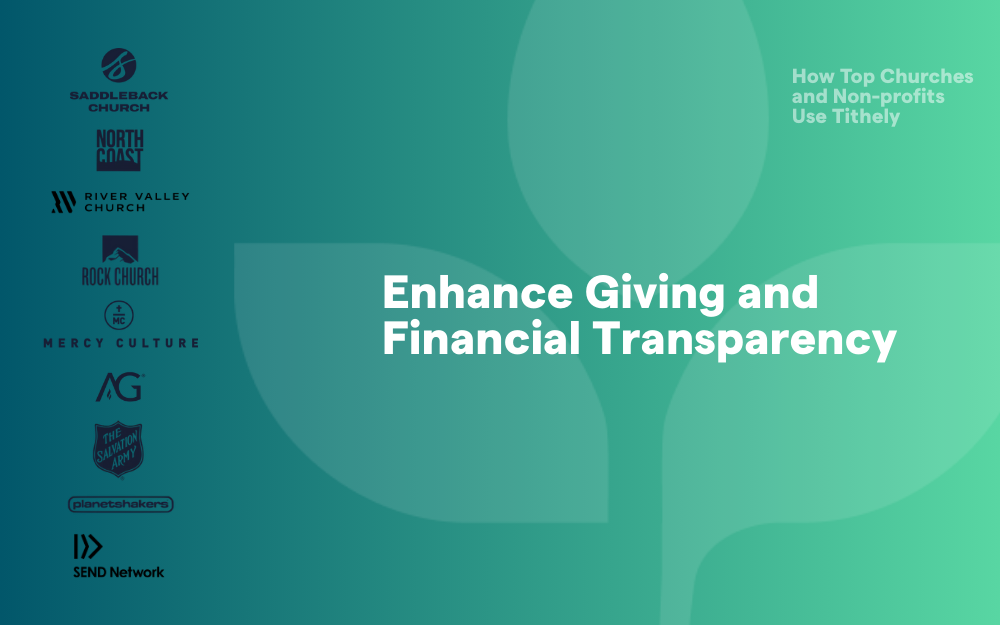Teaching Stewardship at Home: How to Raise Generous Kids in a Consumer Culture
Discover practical, faith-based strategies to instill generosity and stewardship in your children amidst today's consumer-driven society.

Have you ever had one of those moments when your kid asks for a $50 LEGO set five minutes after opening birthday presents?
Welcome to parenting in a consumer culture.
We’re raising kids in a world where spending is the norm, giving is the afterthought, and "more" is always the goal. As parents, it can feel overwhelming to swim against that tide.
But here’s the good news: you don’t need a theology degree or an envelope system to raise generous kids. You just need to plant seeds early and keep showing up.
Let’s talk about how to teach stewardship at home in a way that’s practical, biblical, and actually doable among the million other things happening in your day.
What Stewardship Actually Means (It’s Bigger Than Tithing)
First, let’s clear something up. Stewardship isn’t just about dropping money in the offering basket (or clicking a button online). It’s about how we manage everything God has given us — our time, our money, our resources, our talents.
When you teach your kids stewardship, you’re not just teaching them how to give—you’re teaching them how to live with purpose.
Stewardship is a mindset.
It’s an invitation to use what we’ve been entrusted with in a way that honors God and serves others.
Biblically, it shows up all over the place:
- The Parable of the Talents (Matthew 25)
- Luke 16:10 - "Whoever can be trusted with very little can also be trusted with much"
- Proverbs 22:6 - "Train up a child in the way he should go, and when he is old he will not depart from it.”
Stewardship isn’t just a church topic. It’s a family rhythm.
Consumer Culture Is Loud. Stewardship Is Countercultural.
Let’s be real: your kid is being marketed to all day long.
From YouTube pre-roll ads to cereal box prizes to birthday parties that feel like mini-weddings—the pressure to consume is relentless.
And honestly? It’s exhausting.
But that’s exactly why stewardship matters so much. We can’t silence the noise, but we can teach our kids to hear a different voice. One that says, “You have enough.” One that says, “You can use your money to help others, not just yourself.”
We’re not aiming for perfect, minimalist kids who never want toys. We’re aiming for grounded, generous kids who know that their worth doesn’t come from what they own.
5 Ways to Model and Teach Stewardship at Home
Here are five real-life ways to teach stewardship—no guilt trips and no lectures from the kitchen table. Just real strategies you can use with your kids today, even if your toddler just threw applesauce on the ceiling.
1. Talk About Money Out Loud
Kids pick up way more than we give them credit for—especially when we think they’re not paying attention. So bring them into the conversation early and often.
Let them overhear the why behind your money moves:
- "We gave it to that family because they needed it more than we needed new shoes."
- "We’re saving up for this because it’s important to us, not just because we want it."
- "We skipped the coffee shop today and donated instead—small trade, big impact."
You don’t need a formal money lesson to teach values.
Some of the most impactful lessons happen off-script, like when your kid sees you put a few dollars in the offering plate or watches you explain why you’re choosing a secondhand option instead of something brand-new.
Normalize money conversations that reflect your values, not just your budget. Talk about giving, saving, and choosing contentment in small, everyday moments—at the gas station, at the dinner table, during a Target run when you're this close to impulse-buying a $30 tchotchke.
You’re not just shaping how they spend. You’re shaping how they see money—as a tool, not a trophy.
As something we’re entrusted with, not something we’re owned by.
2. Make Giving a Family Decision
When your family gives—whether it's a tithe, a one-time donation, or dropping a few cans into a food drive bin—bring your kids into it.
Let them help choose the organization. Pull up the charity’s website, watch a short video together, or read a few lines about who the money helps. Then talk about it in simple, kid-friendly terms: “This helps families who don’t always have dinner,” or “This money goes to build wells where kids don’t have clean water.”
Even if the amount is small, the point is to help your child make the connection between giving and impact. It’s not just about dropping money into a basket—it’s about understanding where it goes and who it helps.
Something fun to try is to give your child their own little "give" fund to manage. Let them decide where it goes every month or quarter. It gives them ownership and helps them see generosity as a personal habit, not just something the grown-ups do at church.
3. Use a Save / Spend / Give System
It’s not new, but it works. Grab three jars, old envelopes, or even a shoebox divided with index cards — whatever you’ve got on hand.
Label them Save, Spend, and Give. When your kids get money from birthdays, chores, lemonade stands, or Grandma’s “just because” $10, let them decide how to divide it up.
This simple system does two things:
- It gives them hands-on experience with the idea that money has different purposes.
- It slows down the “spend it all now” reflex that’s so common (in kids and adults).
You don’t need to be strict with percentages—the goal is to build awareness.
Ask questions like:
- “What are you saving for?”
- “Who could you help with part of this?”
- “What’s something fun you’d enjoy spending on soon?”
And when they do make a giving decision?
Celebrate it.
Show them the impact.
Let them feel what it’s like to be cheerful givers—and still have money to enjoy or save.
You’re not micromanaging. You’re building financial instincts that will carry into adulthood. Think of this as a training ground for future generosity—one coin at a time.
4. Celebrate Others’ Wins (Without Envy)
This one’s sneaky important — and a lot harder than it sounds.
We live in a world where everyone shares their highlight reels online. New bikes, family vacations, a playroom that looks like a Montessori catalog—it’s easy for kids (and, let’s be honest, adults) to start comparing and feeling like they’re missing out.
So, how do we flip the script?
When a friend gets something shiny and new, help your kids celebrate it. Say things like:
- “That’s so exciting for them! What a cool gift.”
- “How fun that they get to do that—I wonder what we could do to make them a card or celebrate with them?”
Over time, this builds a mindset that generosity isn’t just about giving stuff—it’s about showing up for others with joy and without jealousy.
And if your kid does feel a little envious?
That’s normal. Acknowledge it. Then gently remind them that someone else’s win doesn’t mean they’re losing.
We want to raise kids who clap when others succeed, not just when they get the prize.
5. Tie Chores to Contribution, Not Just Cash
Let’s talk about chores. Because if your house was anything like mine growing up, “who emptied the dishwasher” can feel like a weekly showdown.
But chores aren’t just a way to earn allowance—they’re a way to teach responsibility, contribution, and stewardship.
Not every job needs a dollar sign attached to it. In fact, some of the best lessons happen when kids help simply because they’re part of the family.
Try saying:
- “We all pitch in because we live here together.”
- “You feeding the dog means you’re helping care for one of God’s creatures.”
- “Wiping the table may seem small, but it helps keep our space healthy and peaceful.”
You can still have paid chores—just be clear about which ones are about contributing and which ones are about earning. This teaches that not all work is transactional. Some of it is just what we do to take care of what we’ve been given.
That’s stewardship, too.
When It Feels Like It’s Not Working (and What to Do About It)
You’ll teach these lessons, and your kid will still beg for another Roblox gift card.
You’ll talk about giving, and they’ll still ask if they can buy more stuff five minutes later.
That doesn’t mean you’ve failed. It means you’re human—and so are they.
Stewardship isn’t a one-and-done talk. It’s not a checklist or a three-week transformation plan. It’s a series of small choices, conversations, and modeled behaviors over time. Think seeds, not instant harvests.
Some days it will feel like nothing’s sticking. Other days, you’ll catch them sharing their snack or putting a few dollars in the offering plate without being asked—and you’ll realize it’s working. Slowly, but surely.
You don’t need to nail this perfectly. You just need to start.
Model generosity. Talk about it often. Invite your kids into the process.
And when you mess it up? Talk about that too. That’s part of the story you’re living.
Sign Up for Product Updates
Have you ever had one of those moments when your kid asks for a $50 LEGO set five minutes after opening birthday presents?
Welcome to parenting in a consumer culture.
We’re raising kids in a world where spending is the norm, giving is the afterthought, and "more" is always the goal. As parents, it can feel overwhelming to swim against that tide.
But here’s the good news: you don’t need a theology degree or an envelope system to raise generous kids. You just need to plant seeds early and keep showing up.
Let’s talk about how to teach stewardship at home in a way that’s practical, biblical, and actually doable among the million other things happening in your day.
What Stewardship Actually Means (It’s Bigger Than Tithing)
First, let’s clear something up. Stewardship isn’t just about dropping money in the offering basket (or clicking a button online). It’s about how we manage everything God has given us — our time, our money, our resources, our talents.
When you teach your kids stewardship, you’re not just teaching them how to give—you’re teaching them how to live with purpose.
Stewardship is a mindset.
It’s an invitation to use what we’ve been entrusted with in a way that honors God and serves others.
Biblically, it shows up all over the place:
- The Parable of the Talents (Matthew 25)
- Luke 16:10 - "Whoever can be trusted with very little can also be trusted with much"
- Proverbs 22:6 - "Train up a child in the way he should go, and when he is old he will not depart from it.”
Stewardship isn’t just a church topic. It’s a family rhythm.
Consumer Culture Is Loud. Stewardship Is Countercultural.
Let’s be real: your kid is being marketed to all day long.
From YouTube pre-roll ads to cereal box prizes to birthday parties that feel like mini-weddings—the pressure to consume is relentless.
And honestly? It’s exhausting.
But that’s exactly why stewardship matters so much. We can’t silence the noise, but we can teach our kids to hear a different voice. One that says, “You have enough.” One that says, “You can use your money to help others, not just yourself.”
We’re not aiming for perfect, minimalist kids who never want toys. We’re aiming for grounded, generous kids who know that their worth doesn’t come from what they own.
5 Ways to Model and Teach Stewardship at Home
Here are five real-life ways to teach stewardship—no guilt trips and no lectures from the kitchen table. Just real strategies you can use with your kids today, even if your toddler just threw applesauce on the ceiling.
1. Talk About Money Out Loud
Kids pick up way more than we give them credit for—especially when we think they’re not paying attention. So bring them into the conversation early and often.
Let them overhear the why behind your money moves:
- "We gave it to that family because they needed it more than we needed new shoes."
- "We’re saving up for this because it’s important to us, not just because we want it."
- "We skipped the coffee shop today and donated instead—small trade, big impact."
You don’t need a formal money lesson to teach values.
Some of the most impactful lessons happen off-script, like when your kid sees you put a few dollars in the offering plate or watches you explain why you’re choosing a secondhand option instead of something brand-new.
Normalize money conversations that reflect your values, not just your budget. Talk about giving, saving, and choosing contentment in small, everyday moments—at the gas station, at the dinner table, during a Target run when you're this close to impulse-buying a $30 tchotchke.
You’re not just shaping how they spend. You’re shaping how they see money—as a tool, not a trophy.
As something we’re entrusted with, not something we’re owned by.
2. Make Giving a Family Decision
When your family gives—whether it's a tithe, a one-time donation, or dropping a few cans into a food drive bin—bring your kids into it.
Let them help choose the organization. Pull up the charity’s website, watch a short video together, or read a few lines about who the money helps. Then talk about it in simple, kid-friendly terms: “This helps families who don’t always have dinner,” or “This money goes to build wells where kids don’t have clean water.”
Even if the amount is small, the point is to help your child make the connection between giving and impact. It’s not just about dropping money into a basket—it’s about understanding where it goes and who it helps.
Something fun to try is to give your child their own little "give" fund to manage. Let them decide where it goes every month or quarter. It gives them ownership and helps them see generosity as a personal habit, not just something the grown-ups do at church.
3. Use a Save / Spend / Give System
It’s not new, but it works. Grab three jars, old envelopes, or even a shoebox divided with index cards — whatever you’ve got on hand.
Label them Save, Spend, and Give. When your kids get money from birthdays, chores, lemonade stands, or Grandma’s “just because” $10, let them decide how to divide it up.
This simple system does two things:
- It gives them hands-on experience with the idea that money has different purposes.
- It slows down the “spend it all now” reflex that’s so common (in kids and adults).
You don’t need to be strict with percentages—the goal is to build awareness.
Ask questions like:
- “What are you saving for?”
- “Who could you help with part of this?”
- “What’s something fun you’d enjoy spending on soon?”
And when they do make a giving decision?
Celebrate it.
Show them the impact.
Let them feel what it’s like to be cheerful givers—and still have money to enjoy or save.
You’re not micromanaging. You’re building financial instincts that will carry into adulthood. Think of this as a training ground for future generosity—one coin at a time.
4. Celebrate Others’ Wins (Without Envy)
This one’s sneaky important — and a lot harder than it sounds.
We live in a world where everyone shares their highlight reels online. New bikes, family vacations, a playroom that looks like a Montessori catalog—it’s easy for kids (and, let’s be honest, adults) to start comparing and feeling like they’re missing out.
So, how do we flip the script?
When a friend gets something shiny and new, help your kids celebrate it. Say things like:
- “That’s so exciting for them! What a cool gift.”
- “How fun that they get to do that—I wonder what we could do to make them a card or celebrate with them?”
Over time, this builds a mindset that generosity isn’t just about giving stuff—it’s about showing up for others with joy and without jealousy.
And if your kid does feel a little envious?
That’s normal. Acknowledge it. Then gently remind them that someone else’s win doesn’t mean they’re losing.
We want to raise kids who clap when others succeed, not just when they get the prize.
5. Tie Chores to Contribution, Not Just Cash
Let’s talk about chores. Because if your house was anything like mine growing up, “who emptied the dishwasher” can feel like a weekly showdown.
But chores aren’t just a way to earn allowance—they’re a way to teach responsibility, contribution, and stewardship.
Not every job needs a dollar sign attached to it. In fact, some of the best lessons happen when kids help simply because they’re part of the family.
Try saying:
- “We all pitch in because we live here together.”
- “You feeding the dog means you’re helping care for one of God’s creatures.”
- “Wiping the table may seem small, but it helps keep our space healthy and peaceful.”
You can still have paid chores—just be clear about which ones are about contributing and which ones are about earning. This teaches that not all work is transactional. Some of it is just what we do to take care of what we’ve been given.
That’s stewardship, too.
When It Feels Like It’s Not Working (and What to Do About It)
You’ll teach these lessons, and your kid will still beg for another Roblox gift card.
You’ll talk about giving, and they’ll still ask if they can buy more stuff five minutes later.
That doesn’t mean you’ve failed. It means you’re human—and so are they.
Stewardship isn’t a one-and-done talk. It’s not a checklist or a three-week transformation plan. It’s a series of small choices, conversations, and modeled behaviors over time. Think seeds, not instant harvests.
Some days it will feel like nothing’s sticking. Other days, you’ll catch them sharing their snack or putting a few dollars in the offering plate without being asked—and you’ll realize it’s working. Slowly, but surely.
You don’t need to nail this perfectly. You just need to start.
Model generosity. Talk about it often. Invite your kids into the process.
And when you mess it up? Talk about that too. That’s part of the story you’re living.
podcast transcript
Have you ever had one of those moments when your kid asks for a $50 LEGO set five minutes after opening birthday presents?
Welcome to parenting in a consumer culture.
We’re raising kids in a world where spending is the norm, giving is the afterthought, and "more" is always the goal. As parents, it can feel overwhelming to swim against that tide.
But here’s the good news: you don’t need a theology degree or an envelope system to raise generous kids. You just need to plant seeds early and keep showing up.
Let’s talk about how to teach stewardship at home in a way that’s practical, biblical, and actually doable among the million other things happening in your day.
What Stewardship Actually Means (It’s Bigger Than Tithing)
First, let’s clear something up. Stewardship isn’t just about dropping money in the offering basket (or clicking a button online). It’s about how we manage everything God has given us — our time, our money, our resources, our talents.
When you teach your kids stewardship, you’re not just teaching them how to give—you’re teaching them how to live with purpose.
Stewardship is a mindset.
It’s an invitation to use what we’ve been entrusted with in a way that honors God and serves others.
Biblically, it shows up all over the place:
- The Parable of the Talents (Matthew 25)
- Luke 16:10 - "Whoever can be trusted with very little can also be trusted with much"
- Proverbs 22:6 - "Train up a child in the way he should go, and when he is old he will not depart from it.”
Stewardship isn’t just a church topic. It’s a family rhythm.
Consumer Culture Is Loud. Stewardship Is Countercultural.
Let’s be real: your kid is being marketed to all day long.
From YouTube pre-roll ads to cereal box prizes to birthday parties that feel like mini-weddings—the pressure to consume is relentless.
And honestly? It’s exhausting.
But that’s exactly why stewardship matters so much. We can’t silence the noise, but we can teach our kids to hear a different voice. One that says, “You have enough.” One that says, “You can use your money to help others, not just yourself.”
We’re not aiming for perfect, minimalist kids who never want toys. We’re aiming for grounded, generous kids who know that their worth doesn’t come from what they own.
5 Ways to Model and Teach Stewardship at Home
Here are five real-life ways to teach stewardship—no guilt trips and no lectures from the kitchen table. Just real strategies you can use with your kids today, even if your toddler just threw applesauce on the ceiling.
1. Talk About Money Out Loud
Kids pick up way more than we give them credit for—especially when we think they’re not paying attention. So bring them into the conversation early and often.
Let them overhear the why behind your money moves:
- "We gave it to that family because they needed it more than we needed new shoes."
- "We’re saving up for this because it’s important to us, not just because we want it."
- "We skipped the coffee shop today and donated instead—small trade, big impact."
You don’t need a formal money lesson to teach values.
Some of the most impactful lessons happen off-script, like when your kid sees you put a few dollars in the offering plate or watches you explain why you’re choosing a secondhand option instead of something brand-new.
Normalize money conversations that reflect your values, not just your budget. Talk about giving, saving, and choosing contentment in small, everyday moments—at the gas station, at the dinner table, during a Target run when you're this close to impulse-buying a $30 tchotchke.
You’re not just shaping how they spend. You’re shaping how they see money—as a tool, not a trophy.
As something we’re entrusted with, not something we’re owned by.
2. Make Giving a Family Decision
When your family gives—whether it's a tithe, a one-time donation, or dropping a few cans into a food drive bin—bring your kids into it.
Let them help choose the organization. Pull up the charity’s website, watch a short video together, or read a few lines about who the money helps. Then talk about it in simple, kid-friendly terms: “This helps families who don’t always have dinner,” or “This money goes to build wells where kids don’t have clean water.”
Even if the amount is small, the point is to help your child make the connection between giving and impact. It’s not just about dropping money into a basket—it’s about understanding where it goes and who it helps.
Something fun to try is to give your child their own little "give" fund to manage. Let them decide where it goes every month or quarter. It gives them ownership and helps them see generosity as a personal habit, not just something the grown-ups do at church.
3. Use a Save / Spend / Give System
It’s not new, but it works. Grab three jars, old envelopes, or even a shoebox divided with index cards — whatever you’ve got on hand.
Label them Save, Spend, and Give. When your kids get money from birthdays, chores, lemonade stands, or Grandma’s “just because” $10, let them decide how to divide it up.
This simple system does two things:
- It gives them hands-on experience with the idea that money has different purposes.
- It slows down the “spend it all now” reflex that’s so common (in kids and adults).
You don’t need to be strict with percentages—the goal is to build awareness.
Ask questions like:
- “What are you saving for?”
- “Who could you help with part of this?”
- “What’s something fun you’d enjoy spending on soon?”
And when they do make a giving decision?
Celebrate it.
Show them the impact.
Let them feel what it’s like to be cheerful givers—and still have money to enjoy or save.
You’re not micromanaging. You’re building financial instincts that will carry into adulthood. Think of this as a training ground for future generosity—one coin at a time.
4. Celebrate Others’ Wins (Without Envy)
This one’s sneaky important — and a lot harder than it sounds.
We live in a world where everyone shares their highlight reels online. New bikes, family vacations, a playroom that looks like a Montessori catalog—it’s easy for kids (and, let’s be honest, adults) to start comparing and feeling like they’re missing out.
So, how do we flip the script?
When a friend gets something shiny and new, help your kids celebrate it. Say things like:
- “That’s so exciting for them! What a cool gift.”
- “How fun that they get to do that—I wonder what we could do to make them a card or celebrate with them?”
Over time, this builds a mindset that generosity isn’t just about giving stuff—it’s about showing up for others with joy and without jealousy.
And if your kid does feel a little envious?
That’s normal. Acknowledge it. Then gently remind them that someone else’s win doesn’t mean they’re losing.
We want to raise kids who clap when others succeed, not just when they get the prize.
5. Tie Chores to Contribution, Not Just Cash
Let’s talk about chores. Because if your house was anything like mine growing up, “who emptied the dishwasher” can feel like a weekly showdown.
But chores aren’t just a way to earn allowance—they’re a way to teach responsibility, contribution, and stewardship.
Not every job needs a dollar sign attached to it. In fact, some of the best lessons happen when kids help simply because they’re part of the family.
Try saying:
- “We all pitch in because we live here together.”
- “You feeding the dog means you’re helping care for one of God’s creatures.”
- “Wiping the table may seem small, but it helps keep our space healthy and peaceful.”
You can still have paid chores—just be clear about which ones are about contributing and which ones are about earning. This teaches that not all work is transactional. Some of it is just what we do to take care of what we’ve been given.
That’s stewardship, too.
When It Feels Like It’s Not Working (and What to Do About It)
You’ll teach these lessons, and your kid will still beg for another Roblox gift card.
You’ll talk about giving, and they’ll still ask if they can buy more stuff five minutes later.
That doesn’t mean you’ve failed. It means you’re human—and so are they.
Stewardship isn’t a one-and-done talk. It’s not a checklist or a three-week transformation plan. It’s a series of small choices, conversations, and modeled behaviors over time. Think seeds, not instant harvests.
Some days it will feel like nothing’s sticking. Other days, you’ll catch them sharing their snack or putting a few dollars in the offering plate without being asked—and you’ll realize it’s working. Slowly, but surely.
You don’t need to nail this perfectly. You just need to start.
Model generosity. Talk about it often. Invite your kids into the process.
And when you mess it up? Talk about that too. That’s part of the story you’re living.
VIDEO transcript
Have you ever had one of those moments when your kid asks for a $50 LEGO set five minutes after opening birthday presents?
Welcome to parenting in a consumer culture.
We’re raising kids in a world where spending is the norm, giving is the afterthought, and "more" is always the goal. As parents, it can feel overwhelming to swim against that tide.
But here’s the good news: you don’t need a theology degree or an envelope system to raise generous kids. You just need to plant seeds early and keep showing up.
Let’s talk about how to teach stewardship at home in a way that’s practical, biblical, and actually doable among the million other things happening in your day.
What Stewardship Actually Means (It’s Bigger Than Tithing)
First, let’s clear something up. Stewardship isn’t just about dropping money in the offering basket (or clicking a button online). It’s about how we manage everything God has given us — our time, our money, our resources, our talents.
When you teach your kids stewardship, you’re not just teaching them how to give—you’re teaching them how to live with purpose.
Stewardship is a mindset.
It’s an invitation to use what we’ve been entrusted with in a way that honors God and serves others.
Biblically, it shows up all over the place:
- The Parable of the Talents (Matthew 25)
- Luke 16:10 - "Whoever can be trusted with very little can also be trusted with much"
- Proverbs 22:6 - "Train up a child in the way he should go, and when he is old he will not depart from it.”
Stewardship isn’t just a church topic. It’s a family rhythm.
Consumer Culture Is Loud. Stewardship Is Countercultural.
Let’s be real: your kid is being marketed to all day long.
From YouTube pre-roll ads to cereal box prizes to birthday parties that feel like mini-weddings—the pressure to consume is relentless.
And honestly? It’s exhausting.
But that’s exactly why stewardship matters so much. We can’t silence the noise, but we can teach our kids to hear a different voice. One that says, “You have enough.” One that says, “You can use your money to help others, not just yourself.”
We’re not aiming for perfect, minimalist kids who never want toys. We’re aiming for grounded, generous kids who know that their worth doesn’t come from what they own.
5 Ways to Model and Teach Stewardship at Home
Here are five real-life ways to teach stewardship—no guilt trips and no lectures from the kitchen table. Just real strategies you can use with your kids today, even if your toddler just threw applesauce on the ceiling.
1. Talk About Money Out Loud
Kids pick up way more than we give them credit for—especially when we think they’re not paying attention. So bring them into the conversation early and often.
Let them overhear the why behind your money moves:
- "We gave it to that family because they needed it more than we needed new shoes."
- "We’re saving up for this because it’s important to us, not just because we want it."
- "We skipped the coffee shop today and donated instead—small trade, big impact."
You don’t need a formal money lesson to teach values.
Some of the most impactful lessons happen off-script, like when your kid sees you put a few dollars in the offering plate or watches you explain why you’re choosing a secondhand option instead of something brand-new.
Normalize money conversations that reflect your values, not just your budget. Talk about giving, saving, and choosing contentment in small, everyday moments—at the gas station, at the dinner table, during a Target run when you're this close to impulse-buying a $30 tchotchke.
You’re not just shaping how they spend. You’re shaping how they see money—as a tool, not a trophy.
As something we’re entrusted with, not something we’re owned by.
2. Make Giving a Family Decision
When your family gives—whether it's a tithe, a one-time donation, or dropping a few cans into a food drive bin—bring your kids into it.
Let them help choose the organization. Pull up the charity’s website, watch a short video together, or read a few lines about who the money helps. Then talk about it in simple, kid-friendly terms: “This helps families who don’t always have dinner,” or “This money goes to build wells where kids don’t have clean water.”
Even if the amount is small, the point is to help your child make the connection between giving and impact. It’s not just about dropping money into a basket—it’s about understanding where it goes and who it helps.
Something fun to try is to give your child their own little "give" fund to manage. Let them decide where it goes every month or quarter. It gives them ownership and helps them see generosity as a personal habit, not just something the grown-ups do at church.
3. Use a Save / Spend / Give System
It’s not new, but it works. Grab three jars, old envelopes, or even a shoebox divided with index cards — whatever you’ve got on hand.
Label them Save, Spend, and Give. When your kids get money from birthdays, chores, lemonade stands, or Grandma’s “just because” $10, let them decide how to divide it up.
This simple system does two things:
- It gives them hands-on experience with the idea that money has different purposes.
- It slows down the “spend it all now” reflex that’s so common (in kids and adults).
You don’t need to be strict with percentages—the goal is to build awareness.
Ask questions like:
- “What are you saving for?”
- “Who could you help with part of this?”
- “What’s something fun you’d enjoy spending on soon?”
And when they do make a giving decision?
Celebrate it.
Show them the impact.
Let them feel what it’s like to be cheerful givers—and still have money to enjoy or save.
You’re not micromanaging. You’re building financial instincts that will carry into adulthood. Think of this as a training ground for future generosity—one coin at a time.
4. Celebrate Others’ Wins (Without Envy)
This one’s sneaky important — and a lot harder than it sounds.
We live in a world where everyone shares their highlight reels online. New bikes, family vacations, a playroom that looks like a Montessori catalog—it’s easy for kids (and, let’s be honest, adults) to start comparing and feeling like they’re missing out.
So, how do we flip the script?
When a friend gets something shiny and new, help your kids celebrate it. Say things like:
- “That’s so exciting for them! What a cool gift.”
- “How fun that they get to do that—I wonder what we could do to make them a card or celebrate with them?”
Over time, this builds a mindset that generosity isn’t just about giving stuff—it’s about showing up for others with joy and without jealousy.
And if your kid does feel a little envious?
That’s normal. Acknowledge it. Then gently remind them that someone else’s win doesn’t mean they’re losing.
We want to raise kids who clap when others succeed, not just when they get the prize.
5. Tie Chores to Contribution, Not Just Cash
Let’s talk about chores. Because if your house was anything like mine growing up, “who emptied the dishwasher” can feel like a weekly showdown.
But chores aren’t just a way to earn allowance—they’re a way to teach responsibility, contribution, and stewardship.
Not every job needs a dollar sign attached to it. In fact, some of the best lessons happen when kids help simply because they’re part of the family.
Try saying:
- “We all pitch in because we live here together.”
- “You feeding the dog means you’re helping care for one of God’s creatures.”
- “Wiping the table may seem small, but it helps keep our space healthy and peaceful.”
You can still have paid chores—just be clear about which ones are about contributing and which ones are about earning. This teaches that not all work is transactional. Some of it is just what we do to take care of what we’ve been given.
That’s stewardship, too.
When It Feels Like It’s Not Working (and What to Do About It)
You’ll teach these lessons, and your kid will still beg for another Roblox gift card.
You’ll talk about giving, and they’ll still ask if they can buy more stuff five minutes later.
That doesn’t mean you’ve failed. It means you’re human—and so are they.
Stewardship isn’t a one-and-done talk. It’s not a checklist or a three-week transformation plan. It’s a series of small choices, conversations, and modeled behaviors over time. Think seeds, not instant harvests.
Some days it will feel like nothing’s sticking. Other days, you’ll catch them sharing their snack or putting a few dollars in the offering plate without being asked—and you’ll realize it’s working. Slowly, but surely.
You don’t need to nail this perfectly. You just need to start.
Model generosity. Talk about it often. Invite your kids into the process.
And when you mess it up? Talk about that too. That’s part of the story you’re living.




























